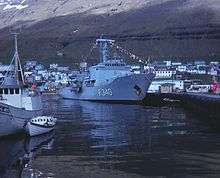EML Admiral Pitka (A230)
 EML Admiral Pitka (A230) | |
| History | |
|---|---|
| Name: | Admiral Pitka |
| Operator: | Estonian Navy |
| Acquired: | 24 January 2000 |
| Commissioned: | 21 November 2000 |
| Decommissioned: | 13 June 2013[1] |
| Motto: | Pro patria |
| Fate: | Scrapped in March 2014, Tallinn, Estonia[2] |
| Badge: |
 |
| Name: | Beskytteren |
| Operator: | Danish Navy |
| Builder: | Aalborg Værft, Aalborg, Denmark |
| Launched: | May 29, 1975 |
| Commissioned: | February 27, 1976 |
| Decommissioned: | November 21, 2000 |
| Fate: | Donated to Estonia |
| General characteristics | |
| Class & type: | Beskytteren class offshore patrol frigate |
| Displacement: | 1,970 tons full |
| Length: | 74.7 m (245 ft 1 in) |
| Beam: | 12.2 m (40 ft 0 in) |
| Height: | 21 m (68 ft 11 in) |
| Draft: | 5.3 m (17 ft 5 in) |
| Propulsion: |
|
| Speed: | 18.5 kn (34.3 km/h) |
| Range: | 6,000 nmi (11,000 km) at 13 kn (24 km/h) |
| Complement: | 8 officers, 35 sailors |
| Crew: | 43 |
| Sensors and processing systems: | 2 Litton Decca E (I-band) navigation radars |
| Armament: |
|
| Aviation facilities: | Helicopter deck for 1 medium helicopter. |
| Notes: | Strengthened for ice operations (A1 ice-class) |
EML Admiral Pitka (A230) was a Beskytteren-class ocean patrol vessel and former flagship of the Estonian Navy, belonging into the Mineships Division. She was named for Estonian Admiral Johan Pitka.
History

As HDMS Beskytteren (F340) the ship, an improved version of the Hvidbjørnen class patrol vessel, was laid down at the Aalborg Shipyard, in Aalborg, Denmark on 15 December 1974. She was launched on 29 May 1975 and entered service a year later on 27 February 1976.[3]
The Danish Navy decommissioned Beskytteren in 2000 and donated the vessel to the Estonian Navy.
The Estonian flag was hoisted on the ship that was built in Aalborg, Denmark on the anniversary of the Estonian Navy, 21 November 2000. The 75-meter frigate was at the time the biggest vessel of the Navy.
The EML Admiral Pitka served more than once as command ship with the joint Baltic mine countermeasures squadron BALTRON and NATO's mine countermeasures group.
Defence Chief Maj. Gen. Riho Terras said in his remarks at the retirement ceremony that the Admiral Pitka was the first unit of the Defence Forces to begin service under the NATO flag only a year after Estonia's accession to the alliance.
The flagship of the Estonian Navy, the Admiral Pitka, was retired on Thursday, 13 June, 2013, and the symbolic title of flagship will pass on to the mine-hunter EML Admiral Cowan (M313).
Navy Chief Captain Sten Sepper handed the vessel's flags and symbols over to the naval school that from now on has a classroom named after Admiral Pitka, military spokespeople said.
The vessel that was received from Denmark as a gift was to be given back to Denmark,[4] but Danes declined and the vessel was scrapped in 2014.[5]
Mission
The command and support frigate Admiral Pitka was the flagship vessel of the Estonian Navy and the Mineships Division and also the first modernized frigate in the navy.
The ship was a platform for the staff that conducts mine countermeasure (MCM) operations and exercises. The ship's responsibilities also included supporting other participating units with fuel, water, food etc. She was equipped with office and living quarters for staff members, as well as special facilities to provide medical support.
The ship was built in Denmark for North Atlantic and Greenland waters; therefore she has strengthened structure for ice operations.
Traditions
The colors of the vessel's coat of arms represented the knights honor on the battlefield and also the connections and joint history between Estonia and Denmark. The shape of the cross pointed to the Estonian Liberty Cross and pointed out Admiral Johan Pitka's important role during the Estonian War of Independence. The ships motto was in Latin „Pro Patria” which means in English "For fatherland". The coat of arms was designed by Priit Herodes and Captain-Lieutenant Jaan Kapp, and were donated to the navy by AS Falck Baltic, being presented during a ceremony on 21 November 2000.[6] In 2001 a cooperation contract was signed between the Rakvere city council and the frigate Pitka which gave the vessel the right to wear the Rakvere town coat of arms and to introduce the city in all foreign harbors across the world.
See also
References
- ↑ "Estonian Navy Flagship Admiral Pitka Retired". Estonian Ministry of Foreign Affairs. Retrieved 9 April 2014.
- ↑ "GALERII JA VIDEO: admiral Pitkast sai doonor mereakadeemiale". Õhtuleht. Retrieved 9 April 2014.
- ↑ Moore 1979, p. 126.
- ↑ Estonian Review, 07-13 June, 2013; http://www.vm.ee/?q=en/node/17455
- ↑ "Admiral Pitka seadmeid hakatakse kasutama meremeeste väljaõppeks". Delfi. Retrieved 9 April 2014.
- ↑ http://mil.ee/?menu=merevagi&sisu=pitka ENS Admiral Pitka (A230)
- Moore, John. Jane's Fighting Ships 1979–80. London: Jane's Yearbooks, 1979. ISBN 0-354-00587-1.
External links
| Wikimedia Commons has media related to Estonian Naval ships. |
- Estonian Navy
- The BESKYTTEREN promoted to Admiral
- BESKYTTEREN, offshore patrol frigate (1976-2000) - Danish Naval History
| ||||||||||||||||||||||||||||||||||||||||||||||||||||||||||||||||||||||||||||||||||||||||||||||||||||||||||||||||||||||||||||||||||||||||||||||||||
| ||||||||||||||||||||||